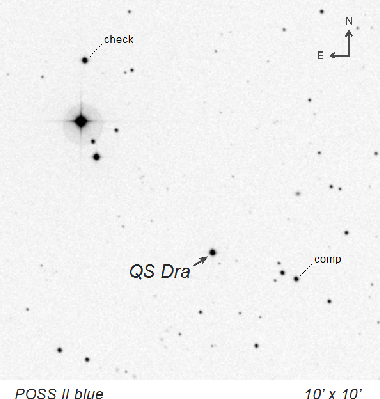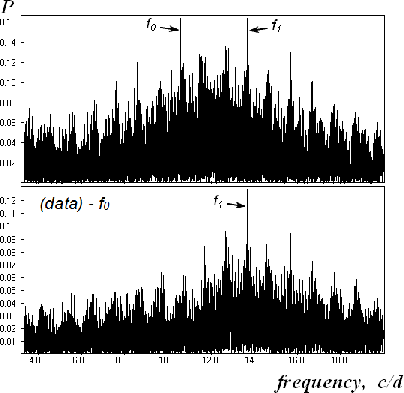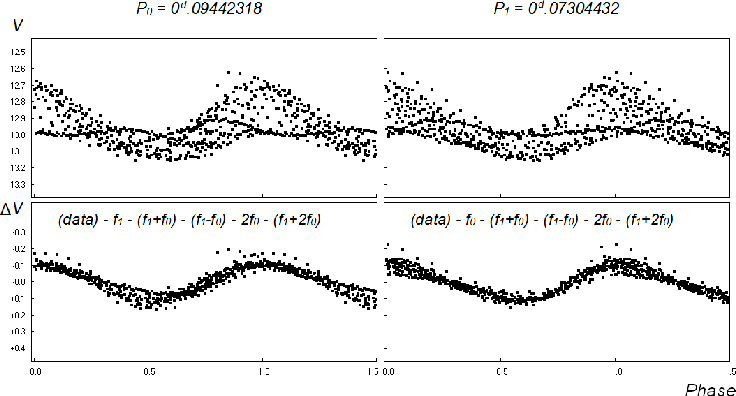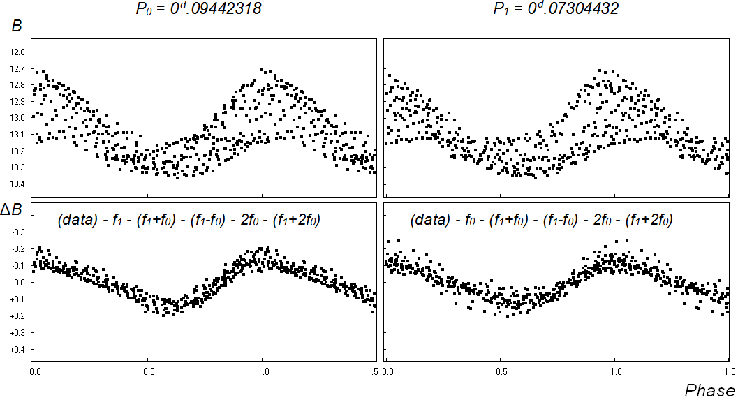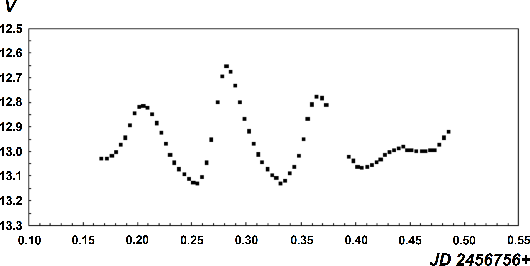|
Peremennye Zvezdy (Variable Stars) 35, No. 2, 2015 Received 06 March; accepted 12 March.
A Photometric Study of the Double-Mode High-Amplitude
|
Article in PDF |
1. Introduction
In this paper, we present the results of our study of QS Draconis,
a double-mode high-amplitude ![]() Scuti variable star, HADS(B)
type. Its coordinates in the GCVS catalog (Samus et al.
2007-2012) are 15
Scuti variable star, HADS(B)
type. Its coordinates in the GCVS catalog (Samus et al.
2007-2012) are 15![]() 21
21![]() 34
34![]() 69, +61
69, +61![]() 29
29![]() 22
22
![]() 7
(J2000.0).
7
(J2000.0).
The variability of QS Dra (GSC 4181-00046) was discovered by one
of the autors (Khruslov 2007) from the publicly available data of
the Northern Sky Variability Survey (NSVS, Wozniak et al. 2004).
The variable was classified as a double-mode high-amplitude
![]() Scuti variable star, DSCT(B) type, pulsating in the
fundamental and first overtone modes. Khruslov (2007) suggested
the following light elements:
Scuti variable star, DSCT(B) type, pulsating in the
fundamental and first overtone modes. Khruslov (2007) suggested
the following light elements:
![]() (fundamental
mode) and
(fundamental
mode) and
![]() (first overtone
mode).
(first overtone
mode).
The period ratio
![]() is typical of double-mode HADS
stars (Petersen & Christensen-Dalsgaard 1996).
is typical of double-mode HADS
stars (Petersen & Christensen-Dalsgaard 1996).
In the present paper, we use a much longer series of observations
that makes it possible to improve the periods and to detect new
interaction frequencies, ![]() ,
, ![]() ,
, ![]() , and
, and
![]() .
.
2. Observations
Our CCD observations in the Johnson
Reductions were performed using the MaxIm DL aperture photometry
package. The finding chart (Fig. 1) identifies the variable star,
comparison star, and check star. The comparison star was GSC
4181-00052, 15![]() 21
21![]() 16
16![]() 04 +61
04 +61![]() 28
28![]() 45
45
![]() 2
(J2000.0), and the check star, GSC 4181-00443, 15
2
(J2000.0), and the check star, GSC 4181-00443, 15![]() 22
22![]() 04
04![]() 16
+61
16
+61![]() 34
34![]() 18
18
![]() 8 (J2000.0). The magnitudes of the
comparison star are
8 (J2000.0). The magnitudes of the
comparison star are
![]() and
and
![]() (Johnson's
system) in the AAVSO Photometric All-Sky Survey (APASS,
http://www.aavso.org/download-apass-data) catalog. The
(Johnson's
system) in the AAVSO Photometric All-Sky Survey (APASS,
http://www.aavso.org/download-apass-data) catalog. The ![]() -band
magnitudes could be presented only as magnitude differences with
respect to the comparison star.
-band
magnitudes could be presented only as magnitude differences with
respect to the comparison star.
Our observations are available online in the html version of this paper.
3. Results
We analyzed the time series using Deeming's method implemented in the WinEfk code written by V.P. Goranskij. Using our observations of QS Dra, we improved the frequencies
| Mode | Period, d | Epoch, HJD 2456565+ | ||
| 0.09442318 | 0.0738 | 0.0777 | 0.0783 | |
| 0.07304432 | 0.0552 | 0.0555 | 0.0563 | |
| Mode | Frequency, c/d | Period, d | Semi-amplitude, mag | ||
| 10.590620 | 0.09442318 | 0.1188 | 0.1073 | 0.0814 | |
| 13.690318 | 0.07304432 | 0.1152 | 0.1041 | 0.0852 | |
| 24.28086 | 0.0411847 | 0.0336 | 0.0272 | 0.0223 | |
| 3.0998 | 0.3226 | 0.0234 | 0.0196 | 0.0155 | |
| 21.18128 | 0.0472115 | 0.0204 | 0.0112 | 0.0088 | |
| 34.87155 | 0.02867667 | 0.0107 | 0.0040 | 0.0038 | |
The light curves of QS Draconis in the ![]() ,
, ![]() and
and ![]() bands are
displayed in Figs. 3, 4, 5. Along with the light curves, we
present power spectra of QS Draconis, for the raw data and after
subtraction of the fundamental-mode oscillations (see Fig. 2).
bands are
displayed in Figs. 3, 4, 5. Along with the light curves, we
present power spectra of QS Draconis, for the raw data and after
subtraction of the fundamental-mode oscillations (see Fig. 2).
The star varies within the following range: the ![]() -band range is
12
-band range is
12![]() 71 - 13
71 - 13![]() 37; the
37; the ![]() -band range is from 12
-band range is from 12![]() 63 to
13
63 to
13![]() 16. The amplitude in the
16. The amplitude in the ![]() band is 0
band is 0![]() 43 (range from
43 (range from
![]() to
to ![]() ).
).
Figure 6 exhibits light-curve variations from one cycle to another
during the same night, typical of high-amplitude double-mode
![]() Scuti variables.
Scuti variables.
Acknowledgments: The authors are grateful to Dr. V. P.
Goranskij for providing light-curve analysis software. We wish to
thank M. A. Krugov, N. V. Lichkanovsky, I. V. Rudakov, R. I.
Kokumbaeva, and W. Mundrzyjewski for their assistance during the
observations. This study was supported by the Russian Foundation
for Basic Research (grant 13-02-00664), the Programme
"Transitional and Outburst Processes in the Universe" of the
Presidium of Russian Academy of Sciences, and the program
"Studies of Physical Phenomena in Star-forming Regions and
Nuclear Zones of Active Galaxies" of the Ministry of Education
and Science (Republic of Kazakhstan).
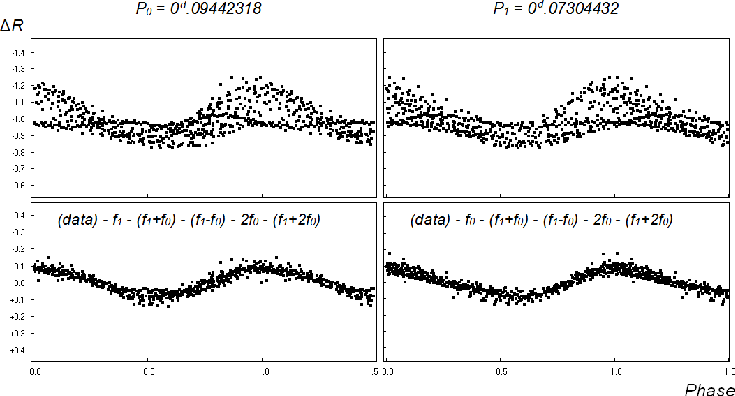 |
Fig. 3.
The light curves of QS Dra, |
References:
Khruslov, A.V., 2007, Perem. Zvezdy Prilozh., 7, No. 25
Petersen, J.O., Christensen-Dalsgaard, J., 1996, Astron. and Astrophys., 312, 463
Samus, N.N., Durlevich, O.V., Kazarovets, E.V., et al., 2007-2012, General Catalogue of Variable Stars, Centre de Donnees Astronomiques de Strasbourg, B/gcvs
Wozniak, P.R., Vestrand, W.T., Akerlof, C.W., et al., 2004, Astron. J., 127, 2436
